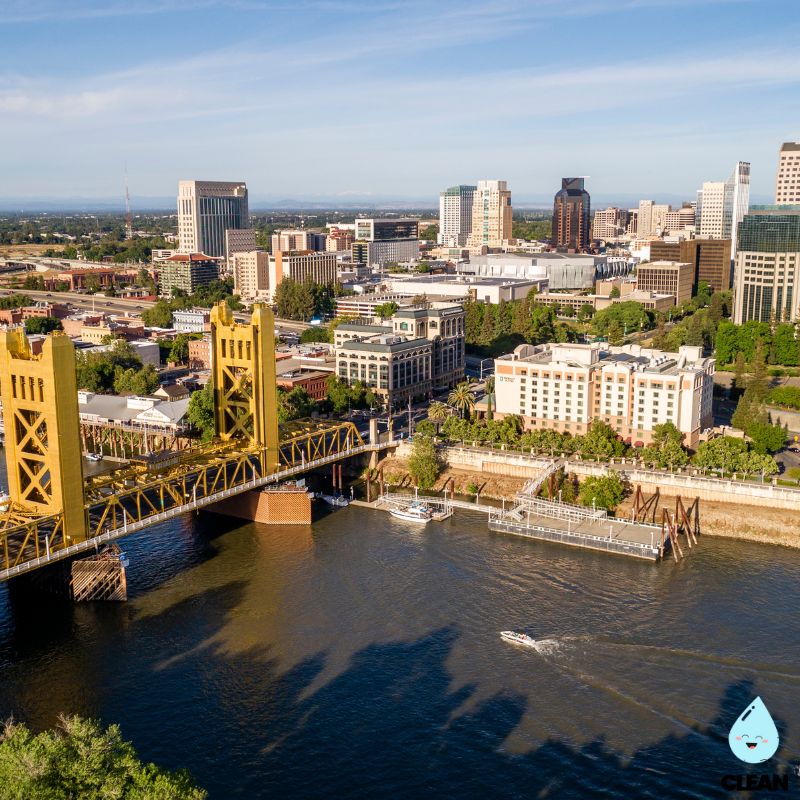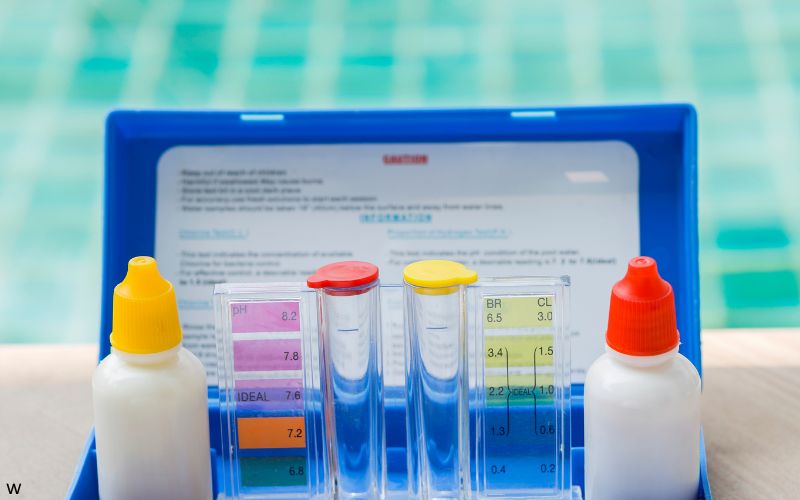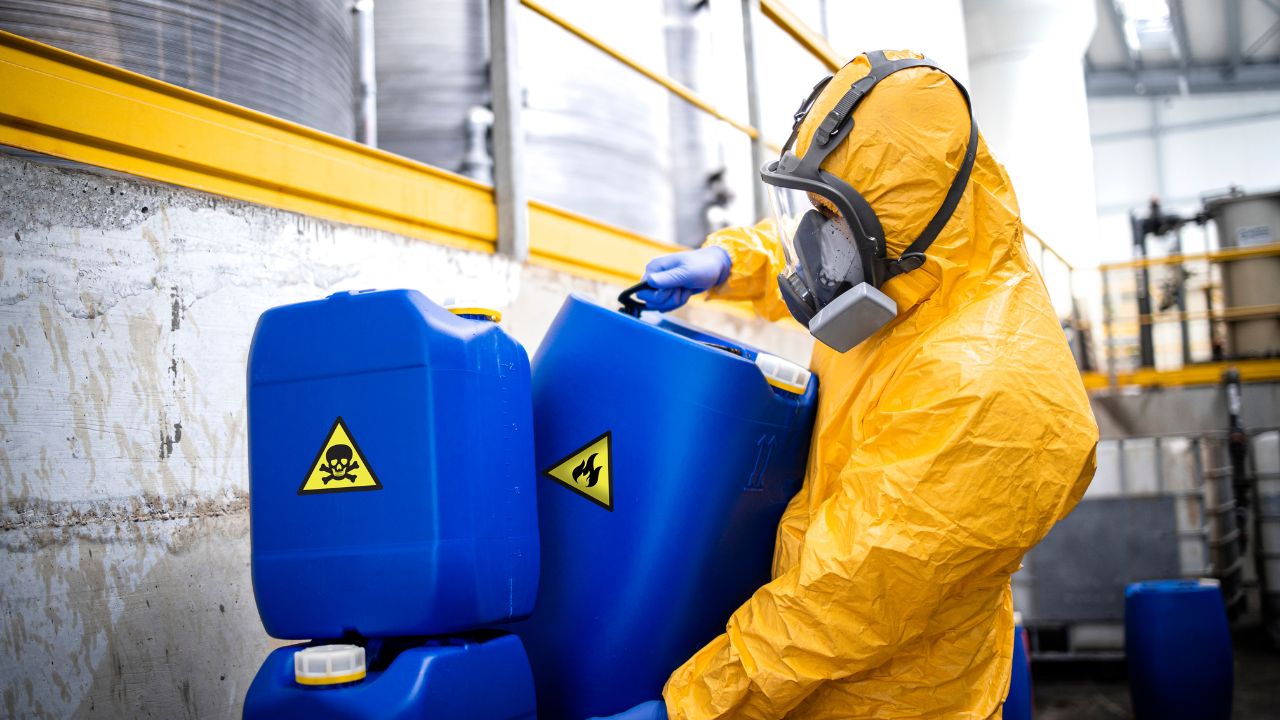Sacramento Water Quality at a Glance
elevated contaminants
Is Sacramento Water Safe to Drink?
Meets Standards, But Has Concerns – Sacramento water meets federal safety standards but contains several contaminants of concern. Key issues include PFOS detected at 41.4 ppt and PFOA at 15.6 ppt (above EPA limits), chromium-6 levels 200x higher than cancer-risk benchmarks (averaging 4,000 ppt), and arsenic levels approaching federal limits. The city draws 80% from surface water and 20% from groundwater wells.
⚠️ Key Concerns for Sacramento Residents
- PFAS “Forever Chemicals”: PFOS at 41.4 ppt and PFOA at 15.6 ppt detected in Well 133 (above EPA standards); affects 500,000+ residents
- Chromium-6 Crisis: Hexavalent chromium averaging 4,000 ppt – 200 times higher than levels with negligible cancer risk
- Arsenic Levels: Approaching federal limit at 4.3 ppb in some wells; known carcinogen linked to cancer and organ damage
- Agricultural Contamination: Surface water vulnerable to pesticides, fertilizers, and runoff from 2+ million acres of agricultural watershed
Read the full report below for detailed analysis, city-specific data, and actionable recommendations for Sacramento residents.
Sacramento – California – Water Quality Report 2025: PFAS Testing, Infrastructure Concerns & Safety across your city
Sacramento’s Department of Utilities provides comprehensive water services to approximately 500,000 residents across California’s capital city and surrounding areas. The municipal utility operates an extensive distribution system encompassing over 1,600 miles of water mains, advanced treatment facilities, and strategic groundwater wells that deliver an average of 80 million gallons of drinking water daily to Sacramento’s diverse urban and suburban communities.
Sacramento sources its drinking water from multiple sources for enhanced reliability: approximately 80% comes from surface water drawn from both the Sacramento River and American River, while the remaining 20% comes from groundwater wells strategically located throughout the city. Surface water is treated at two major facilities – the Sacramento River Water Treatment Plant and the E.A. Fairbairn Water Treatment Plant on the American River. Sacramento’s water meets all federal and state quality standards, though recent testing has revealed concerning levels of PFAS compounds including PFOS at 41.4 ppt and PFOA at 15.6 ppt in Well 133, along with chromium-6 levels averaging 4,000 ppt – 200 times higher than cancer-risk benchmarks.

Sacramento Water Quality: Current Status (2024-2025)
Latest Testing Results
- Comprehensive Monitoring: Sacramento conducts extensive water quality testing for over 100 potential contaminants annually across the distribution system, maintaining compliance with EPA and California State Water Resources Control Board regulations.
- PFAS Detection: Recent testing revealed PFOS at 41.4 parts per trillion and PFOA at 15.6 ppt in Well 133 (February 2024), both exceeding EPA’s new maximum contaminant levels of 4 ppt established in 2024.
- Compliance Status: Sacramento’s water meets all current federal and state drinking water standards, though emerging contaminant levels including PFAS and elevated chromium-6 concentrations present ongoing challenges requiring treatment solutions.
Water Sources
- Sacramento River: Primary surface water source providing treated water through the Sacramento River Water Treatment Plant, drawing from California’s longest river system that collects water from far northern California.
- American River: Secondary surface water source supplying the E.A. Fairbairn Water Treatment Plant, sourced primarily from Sierra Nevada snowmelt stored in Folsom Lake and regulated by Folsom Dam.
- Groundwater Wells: Strategic groundwater facilities throughout the city, with multiple wells serving different service areas including Arden Park Vista, Northgate, Southwest Tract, Hood, East Walnut Grove, Delta Estates, Laguna, Vineyard, Country Creek Estates, Grantline, Mather, Sunrise, and Anatolia neighborhoods.
Advanced Treatment Technology
- Sacramento River Water Treatment Plant: Features multi-barrier treatment including coagulation, flocculation, sedimentation, filtration, and chlorine disinfection, with ongoing evaluation of advanced treatment options for emerging contaminants.
- E.A. Fairbairn Water Treatment Plant: Utilizes comprehensive treatment processes including grit removal, particle aggregation, settling tanks, anthracite and sand filtration, and chemical disinfection for water quality improvement.
- PFAS Treatment Planning: Sacramento County Water Agency estimates $45 million investment needed to install treatment systems for PFAS removal, with approximately 6 of 70 wells requiring treatment to meet new EPA standards.
Infrastructure Modernization
- Water+ Project: Ambitious modernization initiative planned to improve Sacramento’s water infrastructure, enhance treatment capabilities, and improve system resilience for future growth.
- Distribution System Upgrades: Ongoing replacement and modernization of over 1,600 miles of water distribution lines, with priority given to aging infrastructure and areas requiring improved water pressure.
- Lead Service Line Inventory: Sacramento completed required service line material inventories in 2024, confirming no lead service lines or galvanized service lines requiring replacement within the city’s service area.
Customer Protection Initiatives
Sacramento’s Department of Utilities maintains transparent communication through annual Consumer Confidence Reports and regular customer notifications, particularly regarding emerging contaminants like PFAS where monitoring and treatment strategies are evolving. The utility offers conservation rebate programs including incentives for efficient toilets, washing machines, rain barrels, and smart irrigation controllers to help customers reduce water usage while maintaining service reliability. Sacramento is actively planning for compliance with new EPA PFAS regulations, which require initial monitoring by 2027 and full compliance by 2029, ensuring continued protection of public health for all residents served by the municipal water system.
Recommendations for Sacramento Residents

Monitor Water Quality
Stay informed about Sacramento’s water quality through annual Consumer Confidence Reports and quarterly updates. Contact the Department of Utilities at (916) 808-5454 for water quality questions or concerns about taste, odor, or pressure issues. Given recent PFAS detections, consider independent water testing for comprehensive analysis.

Take Advantage of Rebates
Apply for Sacramento’s water conservation rebate programs including up to $125 for high-efficiency toilets, $125 for Energy Star washing machines, $150 for rain barrels, and $100 for greywater systems. Visit the city’s utilities website for current offerings.

Consider Home Filtration
Given Sacramento’s elevated chromium-6 levels (4,000 ppt – 200x cancer-risk benchmarks) and PFAS detections above EPA limits, consider NSF-certified filtration systems. Reverse osmosis systems effectively remove PFAS, chromium-6, and arsenic, while activated carbon filters address chlorine taste and some contaminants.

Practice Water Conservation
Follow California’s water conservation guidelines and Sacramento’s permanent water efficiency measures. Participate in Cash for Grass programs offered by Sacramento County Water Agency and install drought-tolerant landscaping to reduce outdoor water usage.

Report Water Issues
Contact Sacramento Department of Utilities Customer Service at (916) 808-5454 or email utilitiescs@cityofsacramento.org for water main breaks, service issues, or quality concerns. Report problems promptly to help maintain system integrity and public safety.
Frequently Asked Questions
Is Sacramento’s tap water safe to drink?
Sacramento’s tap water meets all current federal and state drinking water standards. The city’s water comes from the Sacramento and American Rivers (80%) and groundwater wells (20%), all of which undergo comprehensive treatment processes.
However, recent testing has revealed concerning levels of PFAS compounds (PFOS at 41.4 ppt and PFOA at 15.6 ppt) exceeding new EPA limits, and chromium-6 levels averaging 4,000 ppt – 200 times higher than cancer-risk benchmarks. While meeting current standards, residents may want to consider filtration systems for additional protection, particularly for vulnerable populations including pregnant women and children.
Why does my water sometimes taste different?
Taste variations can occur due to several factors in Sacramento’s water system:
1. Seasonal source changes: During different times of year, Sacramento may adjust the proportion of river water versus groundwater, which can create subtle taste differences
2. Service area differences: Sacramento is divided into four service areas with varying water sources – some areas receive more groundwater while others receive more treated surface water
3. Chlorine disinfection: Levels may vary slightly based on system demands and seasonal water quality conditions
If taste or odor issues persist, contact Sacramento Department of Utilities at (916) 808-5454. Running cold water for a few minutes after periods of non-use often helps improve water quality from your tap.
What about lead and copper in Sacramento’s water?
Sacramento follows all EPA Lead and Copper Rule requirements and the Lead and Copper Rule Improvements (LCRI):
• Service line inventory: Sacramento completed required service line material inventories in 2024 and confirmed no lead service lines or galvanized service lines requiring replacement within the city’s service area
• Corrosion control: The utility maintains optimized water chemistry and pH levels to prevent leaching of lead and copper from plumbing systems
• Regular testing: Sacramento conducts required lead and copper monitoring at high-risk homes throughout the distribution system, with recent testing showing non-detect results for lead
• School testing: From 2017-2019, Sacramento tested over 600 samples from 132 schools with 97% showing non-detect results (less than 5 micrograms per liter)
Homes built before 1986 have higher likelihood of containing lead solder in internal plumbing. Residents with concerns can contact the Department of Utilities for guidance on testing and protective measures.
Are there water conservation requirements in Sacramento?
Sacramento follows California’s statewide water conservation regulations and local efficiency measures:
Current Requirements:
• No watering of lawns or landscapes during and 48 hours after precipitation
• No washing of driveways, sidewalks, or vehicles with potable water unless a shut-off nozzle is used
• No water runoff from irrigation onto paved surfaces
Sacramento County Water Agency areas:
Some areas served by Sacramento County Water Agency may have additional restrictions. Check with your specific water provider for local requirements.
Rebate Programs:
Sacramento offers various rebates for efficient fixtures, appliances, and drought-tolerant landscaping to help customers reduce water usage while maintaining service.
Quality News About Your Water
Get the comprehensive water quality news coverage you need with our dedicated US Water News Service. From coast to coast, we deliver in-depth reporting and expert analysis on PFAS contamination, EPA regulatory changes, infrastructure developments, and emerging water safety issues affecting communities nationwide. While mainstream media only covers the biggest stories, we provide the detailed, ongoing coverage that helps you understand the full scope of America’s water challenges. Whether you’re a concerned citizen, water professional, or community leader, our daily updates and analytical insights keep you informed about the issues that matter most to public health and environmental safety.
Contaminants of Concern

PFAS Compounds
Source: Per- and polyfluoroalkyl substances from industrial processes, firefighting foams, and consumer products that can enter source waters and groundwater supplies
Health Effects: Research indicates potential health impacts including effects on immune system, thyroid function, cholesterol levels, and possible links to certain cancers including testicular, kidney, liver, and thyroid cancers
Current Status: Sacramento Well 133 tested positive for PFOS at 41.4 ppt and PFOA at 15.6 ppt in February 2024, both exceeding EPA’s new limits. Sacramento County Water Agency estimates 6 of 70 wells require treatment costing approximately $45 million. EPA Limits: 4 ppt for PFOA and PFOS, with Hazard Index of 1 for PFAS mixtures

Chromium-6 & Heavy Metals
Source: Hexavalent chromium occurs naturally in groundwater and through industrial processes; arsenic occurs naturally in groundwater deposits throughout California’s Central Valley
Health Effects: Chromium-6 is a known carcinogen linked to stomach cancers; arsenic is carcinogenic and causes damage to brain, central nervous system, skin, and blood vessels
Current Levels: Sacramento has some of the highest chromium-6 levels among major US cities, averaging 4,000 ppt – 200 times higher than levels with negligible cancer risk. Arsenic levels detected up to 4.3 ppb in groundwater wells. EPA Limits: 10 ppb for chromium-6 (California standard), 10 ppb for arsenic
Please read – our information
The information presented on cleanairandwater.net is compiled from official water quality reports, trusted news sources, government websites, and public health resources. While we strive for accuracy and thoroughness in our presentations, we are not scientists, engineers, or qualified water quality professionals.
Our mission is to present water quality information in an accessible, real-world format that helps people understand what’s in their water and make informed decisions about their health and safety. We believe that complex environmental information should be available to everyone in a format that’s easy to understand.
We make every effort to ensure our content is current and accurate, but we cannot guarantee that all information is complete or error-free. This website should not replace official communications from your local water utility or health department. We always recommend consulting official sources for the most up-to-date information regarding your specific water system.
Clean Air and Water is not liable for any unintentional errors, omissions, or outdated information. The content on this site is provided for informational purposes only and should not be considered professional advice.


